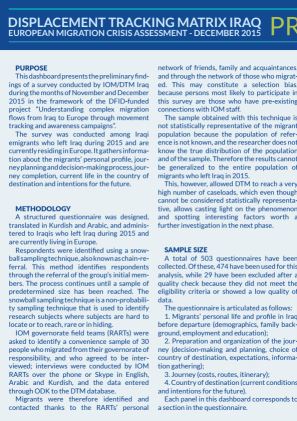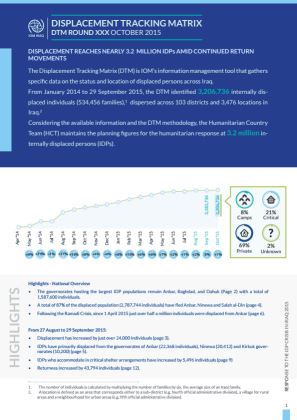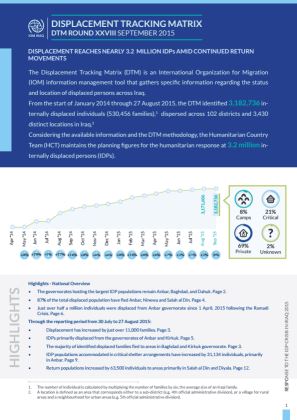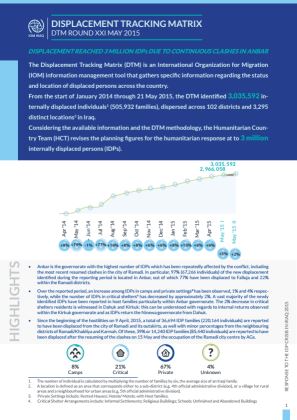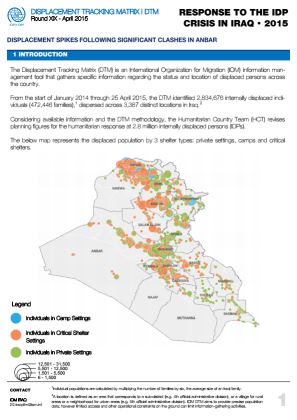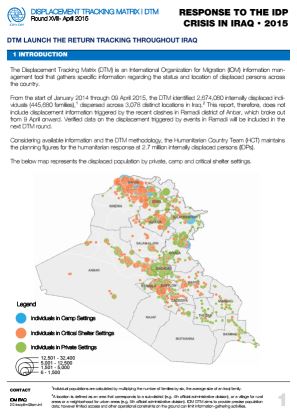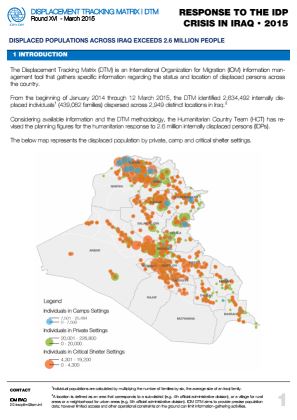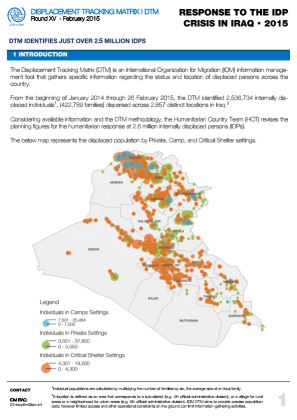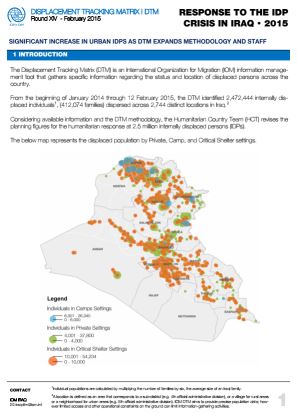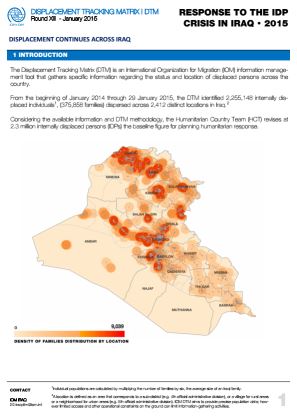-
Countries
-
Data and Analysis
-
Special Focus
-
Crisis Responses
Iraq
Error message
The submitted value field_published_date_value in the Sort by element is not allowed.
IDPs tracked
Displacement Movements
1,169,000
IDMC 2022
Data collection round
About Iraq
Reinforced in January 2014 in response to the need for information on displacement linked to the worsening armed conflict, the DTM programme in Iraq collects key information on internally displaced persons (IDPs) and returnees through different components and methodologies across the entire country.
Through IOM's Rapid Assessment and Response Teams (RARTs) -composed of 140 field staff- present throughout the Iraqi territory, the DTM collects data on numbers and locations of IDPs and returnees using an extended network of over 4,000 key informants. In addition to information collected from key informants, identified locations hosting IDPs are then visited and directly assessed by the RARTs to collect more detailed and in-depth information on the displaced population.
Please visit the Access to Durable Solutions among IDPs in Iraq
Iraq — IDP Locations and Populations (February 2016)
From the start of January 2014 through 04 February 2016, the DTM identified 3,320,844 internally displaced individuals (553,474 families). This maps shows the sizes of IDP population residing in 3 main shelter categories (private, critical, camp plus unknown).
Iraq — Displacement Report 38 (February 2016)
From January 2014 to 4 February 2016, the DTM identified 3,320,844 IDPs (553,474 families), dispersed across 105 districts and 3,698 locations in Iraq.
Feb 04 2016
Iraq — Displacement Report 38 (February 2016)
Iraq — Understanding complex migration flows from Iraq to Europe (November — December 2015)
This dashboard presents the preliminary findings of a survey conducted by IOM/DTM Iraq during the months of November and December 2015 in the framework of the DFID-funded project “Understanding complex migration flows from Iraq to Europe through movement tracking and awareness campaigns”.
Iraq — IDP Shelter Arrangement (January 2016)
From the start of January 2014 through 07 January 2016, the DTM identified 3,290,310 internally displaced individuals (548,385 families). This maps shows the sizes of IDP population residing in 3 main shelter categories (private, critical, camp plus unknown).
Jan 07 2016
Iraq — IDP Shelter Arrangement (January 2016)
Iraq — IDP Locations and Populations (January 2016)
From the start of January 2014 through 07 January 2016, the DTM has identified 3,290,310 internally displaced individuals (548,385 families). This map shows locations where IDPs are currently residing, as well as overall concentrations across the country.
Iraq — Displacement Report 36 (January 2016)
From January 2014 to 7 January 2016, the DTM identified 3,290,310 internally displaced individuals (548,385 families), dispersed across 105 districts and 3,663 locations in Iraq.
Jan 07 2016
Iraq — Displacement Report 36 (January 2016)
Iraq — Migration from Iraq to Europe (December 2015)
This dashboard presents the preliminary findings of a survey conducted by IOM/DTM Iraq during the months of November and December 2015 in the framework of the DFID-funded project “Understanding complex migration flows from Iraq to Europe through movement tracking and awareness campaigns”.
Iraq — Displacement Report 34 (December 2015)
During this round, The total number of identified IDPs has remained largely stable, with a reported increase of less than 1%, i.e.
Dec 04 2015
Iraq — Displacement Report 34 (December 2015)
Iraq — Displacement Report 32 (November 2015)
During this round, The number of identified IDPs has decreased by 1%, i.e.
Nov 09 2015
Iraq — Displacement Report 32 (November 2015)
Iraq — Displacement Report 30 (October 2015)
During this round, Displacement has increased by just over 24,000 individuals. IDPs have primarily displaced from the governorates of Anbar (22,368 individuals), Ninewa (20,412) and Kirkuk governorates (10,200). IDPs who accommodate in critical shelter arrangements have increased by 5,496 individ
Sep 30 2015
Iraq — Displacement Report 30 (October 2015)
Iraq — Displacement Report 28 (September 2015)
During this round, Displacement has increased by just over 11,000 families. IDPs primarily displaced from the governorates of Anbar and Kirkuk. The majority of identified displaced families fled to areas in Baghdad and Kirkuk governorate. IDP populations accommodated in critical shelter arrangeme
Aug 28 2015
Iraq — Displacement Report 28 (September 2015)
Iraq — Displacement Report 26 (August 2015)
During this round, the identified IDP population showed an increase of 2% (58,692 individuals) between 2 and 30 July 2015.
Jul 31 2015
Iraq — Displacement Report 26 (August 2015)
Iraq — Displacement Report 24 (July 2015)
The identified IDP population showed an increase of 1% (25,542 individuals) between 4 June and 2 July, 2015. Following the Ramadi crisis at the beginning of April 2015, more than a quarter of a million individuals were displaced from Anbar governorate.
Jul 03 2015
Iraq — Displacement Report 24 (July 2015)
Iraq — Displacement Report 22 (June 2015)
A total of newly 8,630 displaced families (51,780 individuals) were identified during the reporting period of 21 May through 4 June.
Jun 05 2015
Iraq — Displacement Report 22 (June 2015)
Iraq — Displacement Report 21 (May 2015)
Over the reported period, an increase among IDPs in camps and private settings has been observed, 1% and 4% respectively, while the number of IDPs in critical shelters4 has decreased by approximately 2%.
May 22 2015
Iraq — Displacement Report 21 (May 2015)
Iraq — Displacement Report 20 (May 2015)
100% (20,236 families) of the newly displaced population identified from 25 April to 7 May, 2015, originate from Anbar Governorate, out of which 52% are displaced to Baghdad and 35% within Anbar, followed by Sulaymaniyah, Babylon, and Erbil governorates reporting 3% each.
May 08 2015
Iraq — Displacement Report 20 (May 2015)
Iraq — Displacement Report 19 (April 2015)
Following the outbreak of the Ramadi crisis around 10 April, DTM tracked 133,104 individuals (22,184 families) displaced across fifteen governorates (DTM Anbar crisis update – 8 May).
Apr 27 2015
Iraq — Displacement Report 19 (April 2015)
Iraq — Displacement Report 18 (April 2015)
This round identified a net decrease in the displaced population of 9,588 individuals’. The situation, however, remains highly fluid and variances in figures were observed throughout several governorates.
Apr 10 2015
Iraq — Displacement Report 18 (April 2015)
Iraq — Displacement Report 17 (March 2015)
Consistent with previous reports, this round identified an additional displaced population of 49,176 individuals.
Mar 27 2015
Iraq — Displacement Report 17 (March 2015)
Iraq — Displacement Report 16 (March 2015)
Consistent with previous reports, this issue further identified 97,758 individuals displaced during previous periods of the crisis.
Mar 13 2015
Iraq — Displacement Report 16 (March 2015)
Iraq — Displacement Report 15 (February 2015)
Consistent with the previous report, this round identified further populations displaced during previous periods of the crisis that are predominantly hosted in rented accommodations and with host community households. From the beginning of January 2014 through 26 February 2015, the D
Feb 27 2015
Iraq — Displacement Report 15 (February 2015)
Iraq — Displacement Report 14 (February 2015)
This report records a significant increase of 36,216 families (estimated 217,296 individuals) from the previous round. Of the newly identified populations, 58% (estimated 126,474 individuals) were displaced before 01 September. In addition to this, the remaining 42% were displaced during th
Feb 15 2015
Iraq — Displacement Report 14 (February 2015)
Iraq — Displacement Report 13 (January 2015)
During this round, there has been an overall increase in the displaced population of 13,064 families (estimated 78,384 individuals). This is an increase of 3.6% from the displaced population figure reported on 15 January, 2015.
Jan 30 2015
Iraq — Displacement Report 13 (January 2015)
Iraq — Displacement Report 12 (January 2015)
Through this reporting period, the DTM has tracked and identified an overall increase of 8,904 displaced families (an estimated 53,424 individuals). This is an increase of 2.5% from the displaced population figure reported on 25 December.
Jan 16 2015
Iraq — Displacement Report 12 (January 2015)
Pagination
Pagination
- First page
- Previous page
- …
- 5
- 6
- 7
- 8
- 9
- 10
- 11
- 12
- 13




